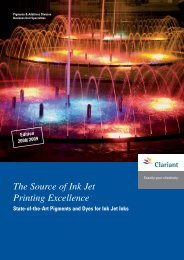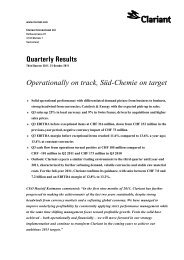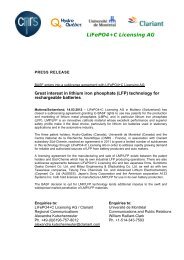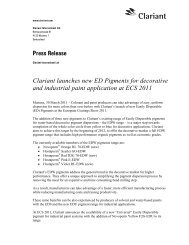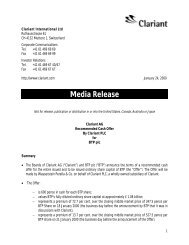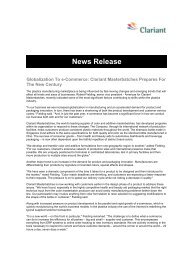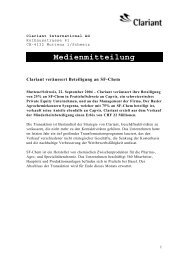DA 3303 E hostanox P-EPQ 09.07 RZ
DA 3303 E hostanox P-EPQ 09.07 RZ
DA 3303 E hostanox P-EPQ 09.07 RZ
You also want an ePaper? Increase the reach of your titles
YUMPU automatically turns print PDFs into web optimized ePapers that Google loves.
Nucleating Properties of<br />
Hostanox P-<strong>EPQ</strong><br />
Figure 1 illustrates the clarifying effect<br />
of Hostanox ® * P-<strong>EPQ</strong> ® measured<br />
on injection molded polypropylene<br />
plaques. After the addition of 0.1%<br />
Hostanox P-<strong>EPQ</strong>, the haze is reduced<br />
by 10 - 15 % compared to the control<br />
sample, whereas P-2 and P-4 have<br />
significantly weaker effects. This<br />
clarity improvement remains nearly<br />
unchanged during multiple extrusion<br />
at 270 °C. Typical clarifiers like NA-1<br />
can even lose their performance under<br />
severe stress conditions (e.g. peak<br />
temperatures, prolonged heat exposure<br />
of the melt), eventually yielding<br />
only marginally improved haze values<br />
in the finished plastic articles.<br />
The improved transparency achieved<br />
just by addition of Hostanox P-<strong>EPQ</strong><br />
correlates with an increase of the<br />
tensile strength (TS) and the crystallization<br />
onset temperature (COT).<br />
As shown in Figure 2, Hostanox P-<strong>EPQ</strong><br />
can improve the tensile strength by<br />
approx. 10 % compared to the reference<br />
(BS only), whereas the competitive<br />
stabilizers have less effect on this<br />
property. The processing stabilizer<br />
Hostanox P-<strong>EPQ</strong> can act to a certain<br />
extent as a nucleating agent. It can<br />
improve the clarity of polypropylene<br />
and enhance its mechanical properties.<br />
Haze (%) after ...<br />
50<br />
40<br />
30<br />
20<br />
10<br />
0<br />
BS only P-<strong>EPQ</strong> P-2<br />
P-4<br />
BS + NA-1<br />
Procedure: Multiple Extrusion at 270 °C.<br />
Specimens: 1 mm Injection Molded Plaques.<br />
Figure 1: Haze of Polypropylene Plaques<br />
1st Extrusion 3rd Extrusion 5th Extrusion<br />
Additives: BS: 0.05 % AO-2 + 0.1 % CaSt;<br />
0.1 % Processing Stabilizer each;<br />
0.25 % Nucleating Agent NA-1.<br />
Tensile Strength<br />
(N/mm<br />
30<br />
150<br />
2 ) TS COT<br />
COT (°C)<br />
20<br />
10<br />
0<br />
BS only P-<strong>EPQ</strong> P-2<br />
P-4 BS + NA-1<br />
Procedure: Mechanical Testing and DSC<br />
Performed after one Extrusion Pass<br />
at 270 °C.<br />
Specimens: 1 mm Injection Molded Plaques.<br />
Additives: BS: 0.05 % AO-2 + 0.1 % CaSt;<br />
0.1 % Processing Stabilizer each;<br />
0.25 % Nucleating Agent NA-1.<br />
Figure 2: Crystallization Onset Temperature (COT) and Tensile Strength (TS) of Polypropylene Random Copolymer<br />
100<br />
50<br />
0<br />
3





